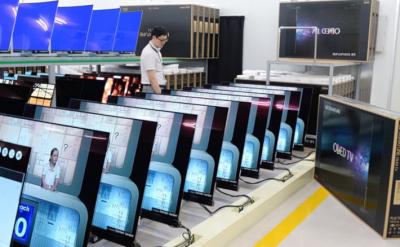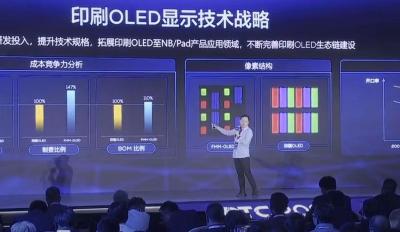OLED TVs offer excellent image quality, outperforming LCDs with superb contrast, excellent and vivid color reproduction and fast refresh rates. In addition, OLEDs enable thin and efficient TVs. OLED TV production has been increasing up until a year ago, reaching a potential capacity of around 10 million units. This is impressive, but considering the entire global TV market that amounts to around 250 million units, OLEDs represent only around 2.5% of the total market (it is important to note that OLEDs tend to be produced in large sizes and carry a much higher average selling price compared to LCDs).
But OLED TV production capacity growth has declined in recent years. In this article we will shortly detail the history of OLED TV production, and look at potential paths towards increased penetration in the future. More details and into the future of OLED technologies and OLED TVs is included in the OLED Toolbox.
A bit of history: in 2013, both Samsung and LGD started producing OLED TV panels. Samsung chose the straightforward RGB side-by-side architecture, in which there are three sub-pixels, with red, green and blue OLED emitters. LG chose its own WRGB (or WOLED) architecture (the IP was acquired from Kodak in 2009) which uses four white OLED subpixels (made from yellow and blue OLED subpixels). Both companies released 55" FHD OLED TVs, priced at over $10,000 per unit. It soon became clear that Samsung's approach was not scalable, while LGD managed to enter mass production quickly and reduce prices dramatically within a few years to compete with the dominant LCD TV technology.
Up until 2022, LGD remained the only OLED TV panel supplier, slowly increasing its production capacity as OLED TVs took over the premium TV market. LGD offered its panels to almost all TV producers, including LG Electronics, Sony, Panasonic, Skyworth, Toshiba, Philips and more. Samsung meanwhile, offered QD-enhanced LCDs to cater for the same premium market segment. In 2022, Samsung Display started production of its rival QD-OLED TV panels which offers quite similar performance and price to LGD's WOLED panels. SDC's capacity however is relatively low, only around 1.5 million panels per year (and most of the capacity actually went to cater for the growing gaming monitor market). SDC's TV panel capacity mostly went to Samsung Electronics, and Sony.
In 2023, Samsung Electronics signed a long-term supply agreement with LG Electronics for WOLED TV panels, and today Samsung offers both QD-OLED and WOLED panels in its high-end TV range (interestingly, one of its models uses both QD-OLED and WOLED panels). There are no indications (quite the opposite, in fact) that Samsung Display is considering increasing its QD-OLED panel production capabilities, as the company is mostly focused on small-size and medium-sized OLED TV panel production and technology to target the more lucrative smartphone, IT, wearable and automotive markets.
It seems as if the OLED industry has reached somewhat of a saturation with regards to OLED TV panels. The premium TV market is currently served by WOLED, QD-OLED and QD-enhanced LCDs (also mini-LED backlit), and gaining much market share in this market is not easy. Increasing the adoption of OLED TV panels will require lower cost production as the rest of the market will not tolerate higher prices. The TV market below the premium segment is highly dominated by price - most consumers just aim to get a decent TV, the largest they can afford for their budget.
It seems as if there are three main ways for the OLED industry to increase its capacity. One way will be for more players to enter production targeting the premium market, which will put a pressure on LGD, and SDC to reduce panel prices. This is a difficult path as it will mean that a display maker will have to invest billions of dollars, with a risk of not being able to recover the investment as margins will be very low (a race to the bottom). We do know that China's BOE has started initial OLED TV panel production (with even some commercial sales) but it doesn't look as if the company is ready to begin real mass production.
A second path forward will be for OLED makers to adopt next-generation technologies that will enable lower cost production. This is easier said than done, as current evaporation-based processes over large area substrates are very cost effective and mature. One possible new technology that display makers have considered for many years is the adoption of inkjet printing to reduce production costs. Interest in ink jet printing has erratic over the last two decades, and today it seems as if the main force behind the technology is China's TCL CSoT. The company is building an ink-jet printing production line, however it seems as if it has shifted its focus towards IT displays for its commercial pilot-level line it is bringing online. Another possible technology is UDC's OVJP, which promises a combination of evaporation materials processing with an inkjet printing type of process.
A third path forward will be for OLED TV makers to find ways to increase the adoption of OLED TVs by adding new functionality or increasing performance, thus in effect increasing the size of the premium market segment. This is not an easy fit, especially as LCD TV makers have historically found ways to match the performance of OLEDs in many aspects. One example is the adoption of technologies that make OLED TVs suitable for gamers - higher refresh rates and response times and the inclusion of interfaces and technologies specifically for gamers. Another example could be the OLED-as-a-sensor platform vision, that adds more functionality (such as cameras, or speakers) into the OLED panel thus making it more cost effective to adopt an OLED instead of an LCD plus other components.
In recent years we have also seen OLED TV makers approach new markets such as the aerospace market, and the transportation market. These are high value markets but the total volume required by such markets is small compared to the consumer TV market.
We find it challenging to envision a clear path towards a dramatic increase in OLED TV production capacity in the next 3-5 years. But it is important to monitor this market as it is just as likely that we do not yet know the market dynamics, the technology advances and the disruptions ahead. This will be an interesting market segment to watch!
For more information on OLED TV production processes, recent OLED TV trends, our view of the future of this industry, the gaming monitors markets, and lot's more - consult the OLED Toolbox, which provides a comprehensive OLED industry guide, data tools, expert articles, trend analysis and insights and a library of 3rd party OLED information items.


